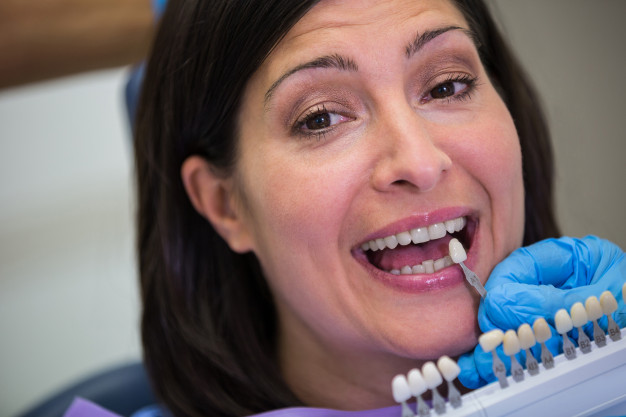All You Need to Know About Tooth Shade Guide
Electric white teeth improve the attractiveness, and if your teeth aren’t in the right shade you might not feel confident to smile freely. The shape and shade of your teeth make you unique, fortunately, you can make both perfect with suitable cosmetic dentistry procedures. Teeth discoloration is very common, and you should consult your dentist immediately if you are noticing discoloration due to one reason or the other. Dentists use a tooth shade guide to help you choose the right shade during whitening or other dental restoration procedures. Whatever is your goal, selecting the accurate shade is very crucial in aesthetic restorative dentistry. Perception of color varies from person to person, and to achieve desired results, dentists use a tooth shade guide for clear, concise, and consistent color match.
What is a Tooth Shade Guide?
Restorative dentistry requires an understanding of science and art of color to enhance dental aesthetics and functionality of the dental system. The aesthetic improvisation depends on position, contour, texture, and color. Here comes the use of a tooth shade guide, a color matching tool, to identify matching color and shade.
Following acceptance of Munsell’s color theory, the tooth shade guides were developed in 1920 to determine color in terms of Hue, Chroma, and Value. Hue suggests the main color in the shade, shown as A, B, C, and D on a Vita Classic Shade Guide.
Chroma is the intensity of the hue, represented by numbers in increasing order. Value signifies the brightness, i.e. the amount of reflected light, shown in a white-to-gray scale. So, if you want to increase the brightness (Value) of the crown, your dentist will either reduce the chroma or increase the reflectivity.
Tooth shade guides are of two types, namely Manual Shade Guide and Technology Assisted Shade Guide. The manual shade guide is either Hue-based or Value-based. However, the majority of shade guides are hue-based not value-based as the human eye is more sensitive to Value compared to the intensity of the hue i.e. Chroma. So, dentists always strive to achieve value matching than hue matching.
In Vita Classical Shade Guide, which is hue-based, four hues are Reddish Brown (A), Reddish Yellow (B), Grey (C), and reddish Grey (D).
Compared to Manual Shade Guides, Technology-Assisted Shade Guides are more consistent and accurate for shade matching. These are three types of technology-assisted shade guides, namely RGB Devices, Colorimeter, and Spectrophotometer. Although commercially obsolete, RGB Devices are the least complicated. The process involves capturing images, chromatic mapping, and shade information creation.
Colorimeter, designed to work like the human eye, uses a color filter to cut spectral load to RGB wavelengths from the tooth. The device is more accurate than the RGB device and delivers results quickly.
On accuracy parameters, spectrophotometers beat all in color measurements. It captures and measures radiant energy reflected from the tooth one wavelength at a time, thus delivering accurate Hue, Value, and Chroma.
Art of Tooth Shade Selection

Now you know the fundamentals of a tooth shade guide. The quality of the device matters, but you will get quality output only when you follow these principles of shade selection:
- The dentist should view the patient at the eye level for better retinal color capture
- Shade selection should happen in different lighting conditions, ideally under incandescent and fluorescent lighting followed by natural light.
- Teeth should be properly cleaned before shade matching.
- Cover bright-colored clothing and remove lipstick to get an accurate color comparison.
- Color samples should be placed next to the tooth matched for better shade comparison.
- Immediately before comparison, the eye should be focused on a grey-blue scale for better sensor balancing.
Take-home Message
Since the perception of color varies, all principles should be followed as per standard practices to get accurate shade comparison. The shading accuracy depends on porcelain used, thickness of porcelain, quality of light, and of course experience of the observer. The goal is to create aesthetically pleasing natural color, and this could happen only in suitable condition with a high-quality tooth shade guide.
